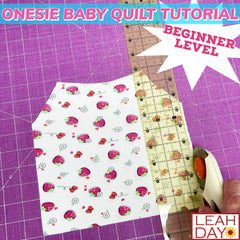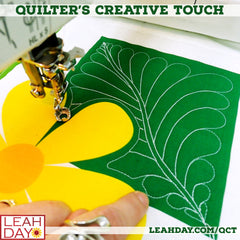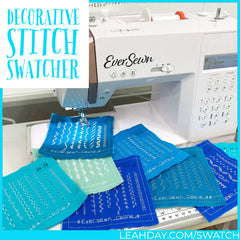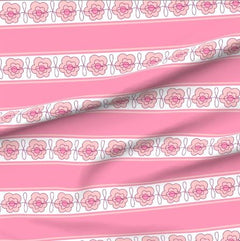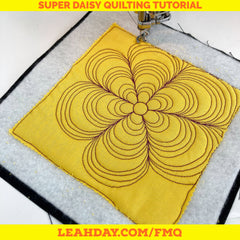Free motion quilting is a particular style of machine quilting which you can do on your home machine, or a long arm quilting machine. To free motion quilt you use a darning foot, which is a special foot designed to hover over the surface of your quilt, allowing you to move the quilt in all directions.
By being able to move in all directions, you can create beautiful designs and patterns over the surface of your quilts. Find hundreds of designs to play with in our Quilting Design Gallery.
Watch as I free motion quilt a funky Zoodle design on my home sewing machine:
As you can see, quilting in free motion allows you to move the quilt freely in all directions. By quilting this way you can minimize the amount you have to rotate and shift a large quilt in your machine, and you can quilt any shape you can imagine: straight lines, curves, circles, and squares, all with this style of machine quilting.
Challenges of Free Motion Quilting
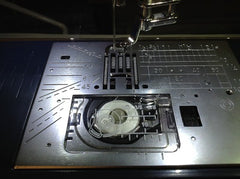 The challenge of free motion quilting is created by the very nature of this quilting style. Being able to move the quilt in all directions requires not using the feed dogs - the little teeth under your presser foot that feed your quilt forward and evenly space your stitches perfectly.
The challenge of free motion quilting is created by the very nature of this quilting style. Being able to move the quilt in all directions requires not using the feed dogs - the little teeth under your presser foot that feed your quilt forward and evenly space your stitches perfectly.
By not using the feed dogs, your machine will not be able to evenly space your stitches. Instead YOU will need to control the stitch length and appearance by balancing the movement of your hands moving the quilt and the speed of your machine operated by your foot pedal.
For this reason, many beginners find free motion quilting challenging to master. Your beautiful, balanced, evenly spaced stitches are suddenly a mess of big and small stitches. Free motion quilting can feel totally out of control as suddenly you are responsible for moving the quilt, creating the design, and keeping the speed of your machine steady as well.
Free Motion Quilting Can Be UGLY!
It should not be surprising that your first free motion quilting won't be very pretty. Actually, it's likely to look something like this:
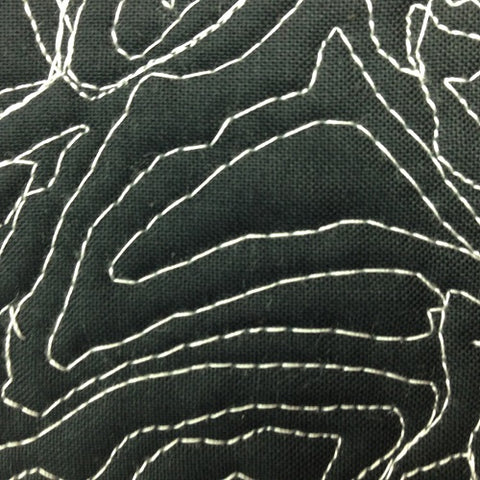
Pretty scary, right?! This is perfectly normal! An essential part of mastering free motion quilting is learning how to quilt through these ugly stitches, figure out how to position your hands, and always match the quilt movement to the speed of your machine.
You can learn all of the basics of free motion quilting in the Free Motion Basics for Beginners video workshop. This two hour workshop will walk you through all the basics of quilting on your machine, balancing your tension, and it includes several quilt projects to practice and master this tricky skill.
Machine Quilting Alternatives
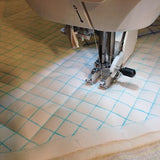 Another style of machine quilting is walking foot quilting, which uses a walking foot to evenly feed the fabric through the machine. This style of quilting does not have the learning curve of free motion quilting because the foot feeds the quilt and your stitches will always be perfectly balanced and evenly spaced.
Another style of machine quilting is walking foot quilting, which uses a walking foot to evenly feed the fabric through the machine. This style of quilting does not have the learning curve of free motion quilting because the foot feeds the quilt and your stitches will always be perfectly balanced and evenly spaced.
The limitation of walking foot style quilting is that you cannot move the quilt in all directions. You must always rotate the quilt so it feeds through your machine facing forward. This will require far more rotation of the quilt, which can be challenging if you have a very small home sewing machine.
Which Style of Quilting is Right for You?
Both styles of machine quilting are worth mastering! Walking foot quilting will be easier and faster to learn because it will feel more like normal sewing and piecing on a sewing machine.
Free motion quilting will take a bit more time and practice to master, but it's absolutely worth it to be able to quilt many beautiful designs over your quilts. Definitely take an online workshop with me to learn the basics so you can master free motion quilting!
Learn more about machine quilting on your home sewing machine


